
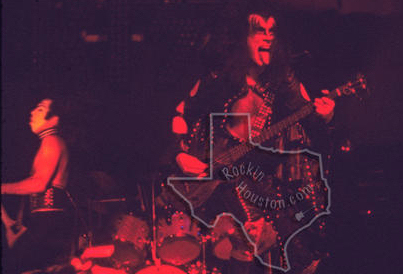

1974 was an eventful year for Paul and his guitars and here appears the first real mystery in the story. This white Flying V guitar first shows up in September and it was probably aquired because the LoBue V was stolen during the Hotter Than Hell recording sessions: "Paul's guitar was stolen on the first day of recording." (Kenny Wise, Nothin' to lose, p. 360 of the eBook) "I took it to Los Angeles to record the second album Hotter Than Hell, and it was stolen out of the recording studio." (Guitars that Rule the World in Metal Edge presents KISS Alive 1996) The first hard evidence I found about this guitar comes from Norwegian fan Ketil Nicolaysen who has asked Paul about this white V. Paul's response: "It was a Flying V knock-off by a guitar maker in New Jersey. I needed a replacement for a V and they only had a white one."
A quick word on the timeline here. There are some photos online that are wrongly dated as Anchorage, AK 1974-06-02 that show this White V. The V isn't present for either the May 31 show in Long Beach, CA nor in San Fransisco, CA on June 1. In fact, in a number of photos from May 31 one can see Ace and Paul's backup guitars stage right and there isn't a V in sight. In those misdated photos Paul also wear a belt that didn't debut until after the Hotter Than Hell photo shoots in August. The photos sometimes labeled as Anchorage, AK are actually from East Lansing, MI on October 21. After Paul had his LoBue V stolen, probably in August, he briefly played the Dan Armstrong seen below and only then did he find this V.
I am indebted to Rik L. Schwinden of KISS tribute band Kissin' Time who ran into a luthier called Kenny Rardin in the early 80's and found out that he was the one who had found Paul's beloved Firebird. I've since been lucky enough to have Kenny answer some questions via Facebook.
A quick word on the timeline here. There are some photos online that are wrongly dated as Anchorage, AK 1974-06-02 that show this White V. The V isn't present for either the May 31 show in Long Beach, CA nor in San Fransisco, CA on June 1. In fact, in a number of photos from May 31 one can see Ace and Paul's backup guitars stage right and there isn't a V in sight. In those misdated photos Paul also wear a belt that didn't debut until after the Hotter Than Hell photo shoots in August. The photos sometimes labeled as Anchorage, AK are actually from East Lansing, MI on October 21. After Paul had his LoBue V stolen, probably in August, he briefly played the Dan Armstrong seen below and only then did he find this V.
I am indebted to Rik L. Schwinden of KISS tribute band Kissin' Time who ran into a luthier called Kenny Rardin in the early 80's and found out that he was the one who had found Paul's beloved Firebird. I've since been lucky enough to have Kenny answer some questions via Facebook.
[Left] Anatomy of an unknown guitar. Quite unlike Paul's taste thus far this custom Doc Potillo had a bolt-on neck with a sizeable heel. Note the unused strap button. Paul elected to have a secondary strap button attacthed to one of the screws of the neck plate.
Before we take a slightly closer look at the mysterious white V there's another backup guitar that passes through the ranks. This Ampeg Dan Armstrong first appears in Wilkes-Barre, PA on September 16 as seen below. When Armstrong was approached by Unimusic, who had then just bought Ampeg, about designing a guitar his aim was clear (pun intended): "From day one, I knew that I wanted something special, something new. I wanted to make not only an artistic statement, but also an electric statement. I didn't just want to build a copy of something that was already out there." (www.danarmstrong.org) Although Armstrong's "see through" guitar (the phrase is actually trademarked in a 1969 brochure) wasn't the first acrylic guitar around it is certainly the most well-known. Apart from the obvious clear body the stand-out features of the guitar are the exchangeable pickup (just slide one out and slide in another) and the fact that it is actually a true bolt-on neck. Regular guitar necks, although they are called bolt-on, are in fact screwed into the body of the guitar. The Armstrong actually had through-going bolts with the nut hidden under the rather sizeable pickguard and driveless domed heads on the back.
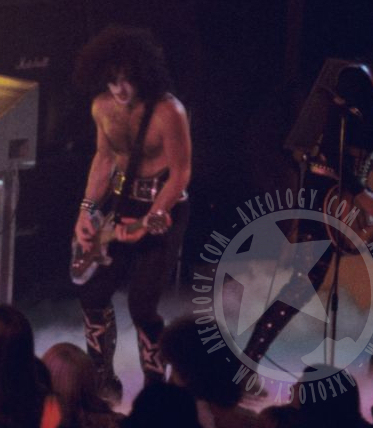

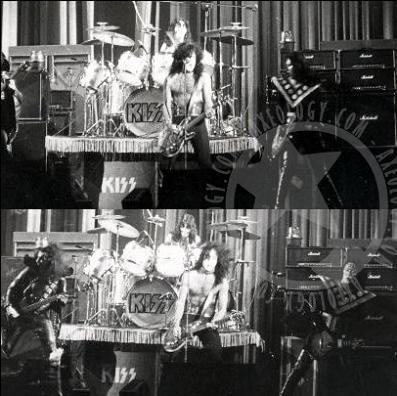
Although perhaps not a bad guitar per se the Dan Armstrong only got real use until the white V shows up and after that it was never more than a very occasional backup. The fact that it shows up in vanishingly few pics seems to suggest that it was never a favourite. After Paul played it in Atlanta, GA on September 18 (see left) Ace uses it in Youngstown, OH October 27 and that's it. It probably stayed on as a backup until the Midnight Special and Firebird I come into the picture in November and December, it can be seen "at the ready" in St. Louis, MO on November 7 and again on November 10 in Wilkes-Barre, MI, but all through September and October the mysterious white V is pretty much all that's captured in photos of Paul.
So, what is this V? According to Kenny Rardin he was told that it was made by a luthier called Doc Potillo and that the headstock inlay, best seen in these two photos from Saginaw, MI on November 10, are in fact the "initials" D.P. Sadly, I have yet to find a single mention of this luthier anywhere.
So, what is this V? According to Kenny Rardin he was told that it was made by a luthier called Doc Potillo and that the headstock inlay, best seen in these two photos from Saginaw, MI on November 10, are in fact the "initials" D.P. Sadly, I have yet to find a single mention of this luthier anywhere.

But, lack of identity aside, it looks like a version of a "standard" Flying V. Twin humbuckers, the usual three knobs (volume/volume/tone) and a three-way switch. The really defining characteristics are the star inlays, the curiously shaped truss-rod cover, and the neck joint. A neck joint that is actually a bolt-on with a sizeable heel. Since pictures that show the back of guitars are relatively more rare than pics showing the front for obvious reasons, this isn't easy to spot. Fortunately there are two pics that at least give a decent view. Below is a shot from Houston, TX on October 4. The neck plate is clearly visible and, thanks to a play of the light, can be seen to be quite distinct from the guitar strap (which is actually also black). The same can't be said of the second pic from Hammond, IN on October 28 but there is that same patch of black of the neck plate.

[Right] Paul giving a rare and revealing look at the bolt-on construction of the mysterious white V. Picture courtesy of the excellent site Rock In Houston.
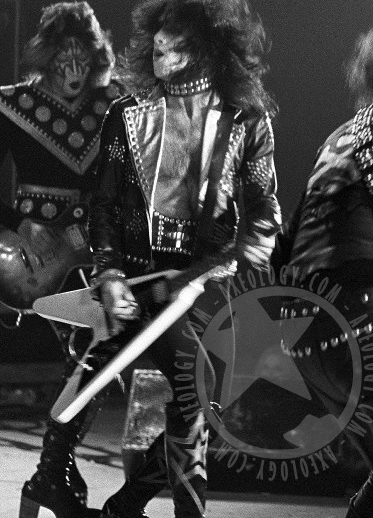

[Left] The white V's last waltz in Atlanta, GA on November 23. The Gibsons take over.
After looking at more Flying V's than I care to admit and finding nothing like this I've come to the admittedly less than stellar conclusion that this is probably a custom guitar of some sort.
Paul has been very silent about this guitar but that's not uncommon, even if he's always seemed keen to talk guitar in interviews if the opportuity arose those types of questions are unfortunately quite few and far between and he's tended to talk about the guitars he was using at the time (especially since he really got into signature models). The reason we really know anything about the LoBue being a LoBue custom is mainly because Paul said so, the headstock logo of the LoBue V is relatively hard to spot in photos. Lacking any word from the man himsels, this remains the most elusive of the guitars Paul has played.
Paul has been very silent about this guitar but that's not uncommon, even if he's always seemed keen to talk guitar in interviews if the opportuity arose those types of questions are unfortunately quite few and far between and he's tended to talk about the guitars he was using at the time (especially since he really got into signature models). The reason we really know anything about the LoBue being a LoBue custom is mainly because Paul said so, the headstock logo of the LoBue V is relatively hard to spot in photos. Lacking any word from the man himsels, this remains the most elusive of the guitars Paul has played.

So, your band has a sponsorship deal with Gibson, things are starting to happen faster and your latest live album is selling like hot cakes. So what do you do for a backup guitar? An Epiphone Coronet? A customized Epiphone Coronet? Paul starts with a sneak previews in Wilkes Barre, PA on September 14 and then, when KISS hit the road in support of Alive! in October, this bastard Coronet shows up first in Ace's hands in Passaic, NJ on October 4 (although there might be a pic from June) and in Toledo in November it can be seen standing next to Gene's LoBue backstage. The picture unfortunately tells us little other than that this is a 1961 or '62 Epiphone Coronet. This is based on the symmetrical body shape and the 3-a-side headstock. The 1964 Coronet had a shorter lower bout and an inline headstock. Thankfully Paul thought it would be a nice idea to show off the new acquisition in the backstage pic below. This also shows us that this is not a pre-1961 Coronet since that model had a different "T-style" metal logo plate on the headstock. (Some early 1961 Coronets actually had the old "T-style" logo plate.) The logo here looks more as if the screened gold decal used in 1962 has been painted around (poorly) but it's really hard to tell. Whatever year this guitar may have been, it had been modified quite a bit.
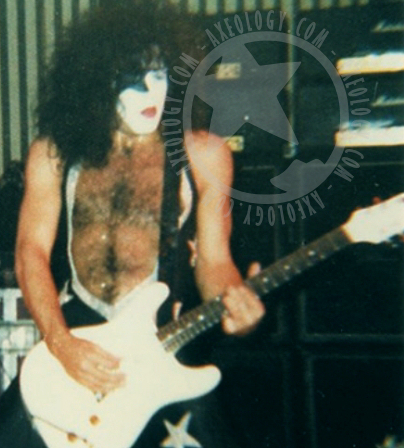
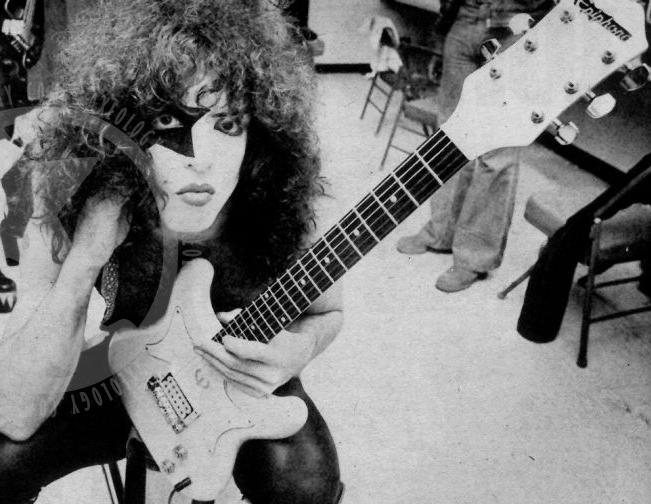
Starting from the top there are new tuning heads installed. The stock Coronet had small oval tuning pegs. These look like mini Schallers M6.
The guitar has been refinished, the catalog Coronet only came in cherry red.
The pickup is obviously one of the band's favored DiMarzios. Although the catalog Coronet in both 1961 and 62 had a small, almost single coil-like chrome-covered pickup (called a New York pickup) most of the ones for sale have a P90 pickup.
The bridge was originally a very simple wraparound bridge and although the details of this bridge aren't clear it looks like a Leo Quan PAF Badass.
The original knobs have been replaced by Gibson-style gold speed knobs.
The guitar has been refinished, the catalog Coronet only came in cherry red.
The pickup is obviously one of the band's favored DiMarzios. Although the catalog Coronet in both 1961 and 62 had a small, almost single coil-like chrome-covered pickup (called a New York pickup) most of the ones for sale have a P90 pickup.
The bridge was originally a very simple wraparound bridge and although the details of this bridge aren't clear it looks like a Leo Quan PAF Badass.
The original knobs have been replaced by Gibson-style gold speed knobs.
[Right] Paul inaugurates the Coronet on stage in Wilkes-Barre, PA.


In 1976 Paul claims to have been a little bored with his Flying V's (not that you could tell from the pictures from the time) and was looking for something new. The result was his white 1976 Gibson Explorer and this beauty, a korina Ibanez Destroyer. "Around the same time [as the white Explorer] I also had an Ibanez Destroyer which was essentially a korina wood Gibson Explorer copy that I gave to Ace. I'm not quite sure why I gave it to him because it was a great guitar." (Guitars that Rule the World) So when this beautiful instrument shows up in Paul's hand in Springfield for the last show of the Alive! tour it may very well still have been his guitar. (Two photos from Los Angeles, CA on February 23 appear to show the same guitar.) Of course, Ace isn't entirely sure. "It's very possible that Paul gave me that guitar, but at the time I was drinking a lot of beer so my memory isn't that clear, but that guitar had an incredible grain to the wood, it was gorgeous." (Guitars that Rule the World in Metal Edge Presents KISS Alive 1996) Although this grain could often get washed out under the stage lights, especially under red light, both pictures presented here show the grain in all its glory and should remove any doubt as to whether it was the same instrument.
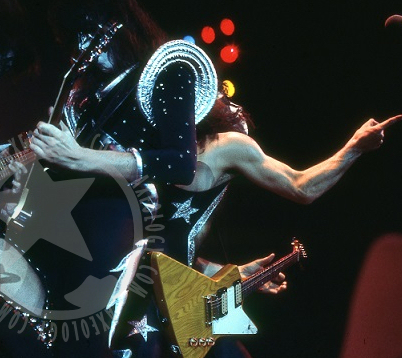

By the time the band took its first trip to Europe Ace used the Ibanez Destroyer a lot, judging by the pictures it more or less shared the time on stage equally with his no. 1 Les Paul Deluxe. Pictures from this time, and also from later on in the year during the Summer of '76 tour, also give some evidence that this was indeed Paul's guitar at first. The original Ibanez Destroyer had an ABR-1 like bridge that was set at a slight angle. The Destroyer in Ace's hands has the blockier Schaller harmonica bridge which is set perpendicular to the strings. From what I've been able to tell Ace never tampered with the bridges on his guitars. Ace has mentioned that he taped over the logo on the headstock (probably because of the deal they had with Gibson) and the guitar does lack a logo when pictured.
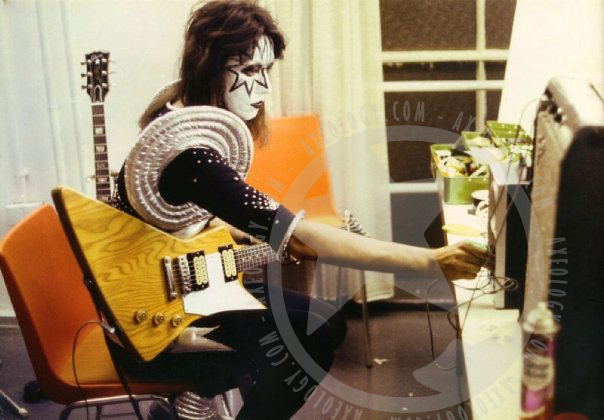
[Left] Ace warming up for one of the dates in Germany in May using his gift from Paul.

In 1977 KISS made their trip to the land of the rising sun for a series of record-breaking concerts and a general level of hysteria even they weren't prepared for. While on that brief tour Paul used at least one guitar by the brand Greco. Exactly what kind of relationship Greco had with the band at the time is unclear but based on the fact that both Paul and Ace played Grecos for parts of the shows and that the 1977 Music Life Special devoted to the tour had a prominent Greco ad they were probably sponsoring the tour to some extent. The Music Life Special also features a few comments and stories about the bandmembers' actively searching for Greco guitars because of their reputation and Paul supposedly bought a total of eight guitars, two of them Greco Mr-1000's, during a visit to a record store(!). This kind of product placement is evidently not uncommon in Japan. (Thanks to Alain for the translations.)
Greco is a long-running player in the Japanese instrument market having started under that name as early as 1960 and was, and is, a brand of the Kanda Shokai corporation. Originally their designs, while indebted to American guitars, were far more original than what later appeared and their real copying of designs didn't really begin until the mid-70's after several big-name touring acts (Led Zeppelin and Pink Floyd among them) had visited the country.
The MR-1000WR (for wine red) played by Paul in the picture on the right was originally a custom guitar built for Mick Ralphs of Bad Company, the factory version of it appearing in advertisements for the first time in 1975. Not unlike a lot of Paul's guitars it had a mahogany body with a maple top and a three-piece maple neck with an ebony fingerboard.
Greco is a long-running player in the Japanese instrument market having started under that name as early as 1960 and was, and is, a brand of the Kanda Shokai corporation. Originally their designs, while indebted to American guitars, were far more original than what later appeared and their real copying of designs didn't really begin until the mid-70's after several big-name touring acts (Led Zeppelin and Pink Floyd among them) had visited the country.
The MR-1000WR (for wine red) played by Paul in the picture on the right was originally a custom guitar built for Mick Ralphs of Bad Company, the factory version of it appearing in advertisements for the first time in 1975. Not unlike a lot of Paul's guitars it had a mahogany body with a maple top and a three-piece maple neck with an ebony fingerboard.
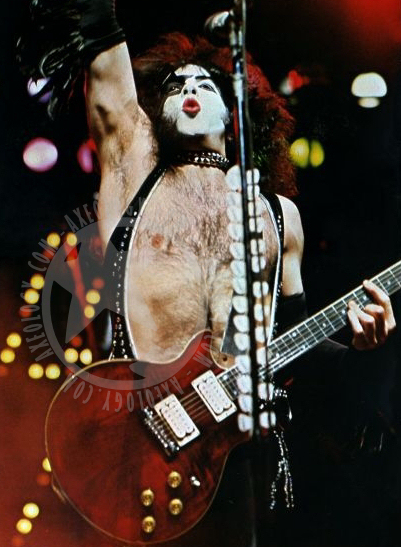
The MR1000 seems to only have been used for the first few dates on the tour. The only dated evidence I've seen puts it at one of the shows in Osaka, either on March 24 or 25. It doesn't appear in any of the footage from Tokyo that was aired as an HBO Special, for that show Paul instead shows up with a white Flying V. Calling this white V a Greco is partly a leap of the imagination and one based mainly on the timing of its appearance. There are no distinguishing marks like a logo on the headstock that actually says that it is anything other than another Gibson Flying V, and the distinct resemblance to Paul's earlier mirror-pickguard V's is uncanny (right down to the Schaller harmonica bridge). But as far as I can tell it only ever shows up for a couple of pictures and in the footage from April 2 in Tokyo, and Greco did have a functioning custom shop that built impressive artist replicas, so I'm going to call it a Greco pending further information. Because...
In this ad from a Japanese magazine we find the PS-800. Greco had a tradition of ridiculously un-imaginative names for their guitars. The Brian May replica was the BM, most of their flying V models were called FV, and, as mentioned above, the MR was originally made for Mick Ralphs. So a mirror-pickguard, single pickup flying V called PS? Much like the AK-1400 (see the Ace section), this particular guitar isn't found in any Greco catalogs from the day and was a special model made for the music store Ikebe Gakki. It was produced in 1977 at the height of KISS-mania in Japan and once in a blue moon you'll see one for sale (total production numbers are unknown but are probably low). The only thing that really points more towards this being a Gibson rather than a PS-800 is that the placement of the knobs on the PS-800 (which actually differ between the ad and this one from eBay) aren't quite right.
In this ad from a Japanese magazine we find the PS-800. Greco had a tradition of ridiculously un-imaginative names for their guitars. The Brian May replica was the BM, most of their flying V models were called FV, and, as mentioned above, the MR was originally made for Mick Ralphs. So a mirror-pickguard, single pickup flying V called PS? Much like the AK-1400 (see the Ace section), this particular guitar isn't found in any Greco catalogs from the day and was a special model made for the music store Ikebe Gakki. It was produced in 1977 at the height of KISS-mania in Japan and once in a blue moon you'll see one for sale (total production numbers are unknown but are probably low). The only thing that really points more towards this being a Gibson rather than a PS-800 is that the placement of the knobs on the PS-800 (which actually differ between the ad and this one from eBay) aren't quite right.
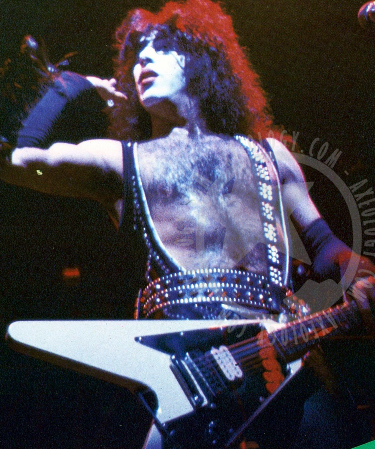

Having been introduced to the band via an apprentice of his that had become Ace's guitar tech, Steve Carr built some truly memorable instruments for KISS. His first was the Axe used for the ViewMaster pictures of Gene and he then worked on Ace's first flasher for the Return of KISS tour. In 1980 he built the guitar extension of Paul's onstage character, the Carr Star guitar. The star-shaped guitar had a rhinestone-covered top, star inlays, a custom star/sword inlay on the headstock, and, according to some sources, an attachment on the back that allowed for the guitar to be spun overhead. The headstock also features an inlay of Steve Carr's "logo".
Despite being a good idea, extending Paul's character to the instrument he played, the guitar itself obviously didn't gain any appeal. It's used for a scant few playback TV appearances, the pic on the right is from the recording of the show Top Pop on September 1. Despite never actually making it on stage the guitar evidently traveled with the band because it's used again for the rendition of Is That You? performed at the soundcheck in Perth on November 8 for the Australian show Countdown.
Despite being a good idea, extending Paul's character to the instrument he played, the guitar itself obviously didn't gain any appeal. It's used for a scant few playback TV appearances, the pic on the right is from the recording of the show Top Pop on September 1. Despite never actually making it on stage the guitar evidently traveled with the band because it's used again for the rendition of Is That You? performed at the soundcheck in Perth on November 8 for the Australian show Countdown.
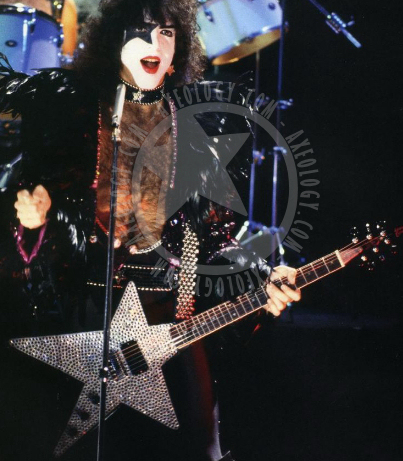

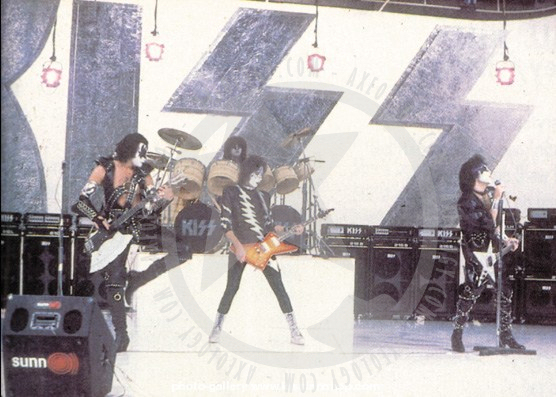

Before being put in mothballs the Carr Star guitar was brought out for the promotional trip to Mexico in 1981. For the lipsynched TV taping on September 25 it was used for I Was Made For Lovin' You and then it was put into storage. It re-appears for the Butterfields auction where it is described as having been "used for photos but never used on stage" (lot 1610, p. 117).
[Right] Why is this man smiling? He doesn't even like this guitar. Top Pop on September 1, 1980.
[Left] Elder-era costumes, Dynasty songs, and a guitar that never got to see the stage. KISS in Mexico 1981.
For the return to Japan in 1978 it seems as if Paul "got off the hook" as far as playing Grecos go (Ace turned up with a flying V-style model called AK-1400) and his connection to Ibanez at the time was probably the reason. Although not owned by the same company there was a spirit of collaboration between Greco and Ibanez in the 70's (according to Jeff Hasselberger, head of Ibanez USA at the time) as Ibanez weren't sold on the Japanese market. For quite some time both brands were also manufactured in the same factories by Fuji-Gen Gakki, Ibanez since 1970 and Greco since 1974.
[Above] The second mysterious white V. Very, very similar to Paul's modded Gibsons but only seen in Japan. Could it be a special PS-800 made for Paul for the shows in Japan?
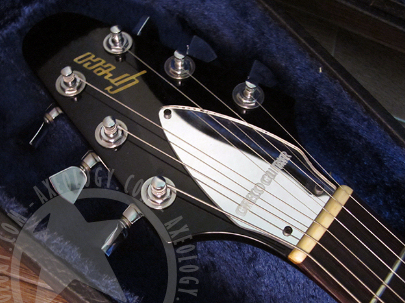

[Right] Headstock of a 1977 PS-800. A very good replica of the Gibson V's Paul played made especially for Ikebe Gakki.
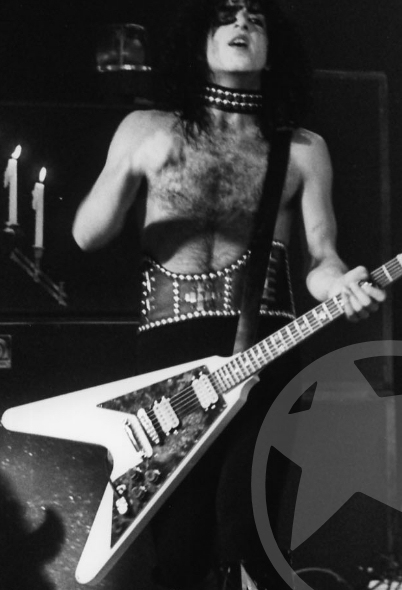

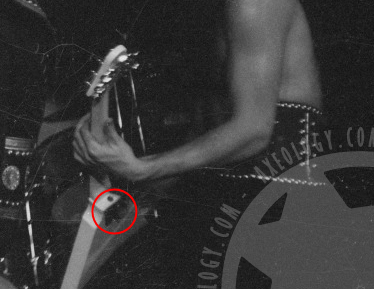
By the time the band took its first trip to Europe Ace used the Ibanez Destroyer a lot, judging by the pictures it more or less shared the time on stage equally with his no. 1 Les Paul Deluxe. Pictures from this time, and also from later on in the year during the Summer of '76 tour, also give some evidence that this was indeed Paul's guitar at first. The original Ibanez Destroyer had an ABR-1 like bridge that was set at a slight angle. The Destroyer in Ace's hands has the blockier Schaller harmonica bridge which is set perpendicular to the strings. From what I've been able to tell Ace never tampered with the bridges on his guitars. Ace has mentioned that he taped over the logo on the headstock (probably because of the deal they had with Gibson) and the guitar does lack a logo when pictured.